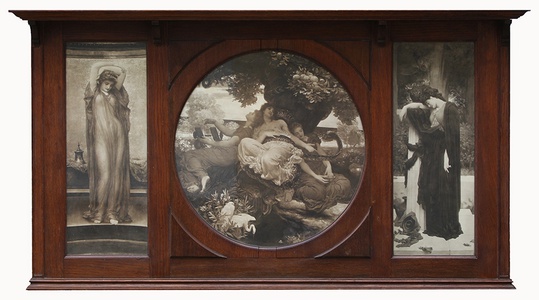| Method | Photogravure |
| Artist | after Frederic Lord Leighton |
| Published | c. 1896 |
| Dimensions | Exterior frame 880 x 1620 mm |
| Notes |
An impressive and highly decorative wooden over mantle, inset with three Frederic Lord Leighton photogravures. The three photogravures used are 'The Frigidarium' on the left, 'The Garden of Hesperides' in the centre, and 'Lachrymae' on the right. These prints were likely published by Arthur Tooth, the publisher for many of Leighton's photogravures. This incredibly rare piece of furniture will likely be unique due to its size and format, being either commissioned by, or made for, the publisher for a customer's home. The Frigidarium shows a female figure stood by the edge of a pool. Her arms are held above her head, wrapped around one another, cradled at the elbows. She wears a sheer, loose fitting gown which shows the shape of her body beneath. She is looking down at the water of the frigidarium, one of the three main bath chambers found in a Roman bath, namely the cold room which often contains a swimming pool. This scene is an excellent example of Leighton's later and established recognisable style. According to Grecian myth, the Hesperides were the maidens who guarded the golden apples given to Hera by Earth in order to commemorate her marriage to Zeus. Frederick Leighton's interpretation of the story shows the Hesperides reclining beneath the tree. Ladon, the dragon, slides over branches and is helixed around the midriff of the central nymph. The figure on the left sings as she plucks a harp, whilst the figure to the right cradles a bowl. Two herons appear by a pool in the foreground. Though Leighton perhaps borrowed the pythonic form of Ladon from Burne-Jones' work of the 1870's, his own version was truer to the narrative. The Hesperides lived on the Westerly border of the ocean, the waves in the background alluding to this. It also appears to be nearing sunset in Leighton's work, which is appropriate as the Hesperides are referred to as the Sunset Godesses, or the Erythrai, meaning the Daughters of Evening. Whilst the Hesperides tended the grove during the day, Hera placed Ladon in the garden, a sleepless dragon who safeguarded the apples by night. As night draws in, and the women recline, the serpent's head vigilantly surveys the area. In Leighton's Lachrymae, it swiftly becomes apparent that the robed figure, leaning despondently against a Doric pedestal, is the personification of mourning. The column which she leans upon is in fact a funerary monument, and behind her, cypress trees are present. Extending from behind the figure is a large cypress tree, based upon a drawing that Leighton made in 1854 whilst he was in Florence. Cypress leaves are littered upon the stones, and by the base of the Doric monument sits a wreath of withered cypress leaves. In classical antiquity, the cypress was a symbol of mourning. When combined with the title Lachrymae, Latin for 'tears', thoughts of grief and melancholy are conjured. Lord Frederic Leighton of Stretton (1830 - 1896) was an English painter of historical and mythological subjects. He was the leader of the Victorian neo-classical painters, and part of the second generation of the Pre-Raphaelite Brotherhood. Leighton was born in Scarborough, though he moved to London in order to receive his initial education at the University College School. From here he travelled to the continent, and trained in Florence, Rome and Frankfurt under artists such as Giovanni Costa and Eduard Von Steinle. He first exhibited at the Royal Academy in 1855. The work depicted Cimabue's Madonna being carried through the streets of Florence, and was bought by Queen Victoria; a Royal endorsement which was to launch a prosperous career. When he settled once more in London in 1860, he associated with the Pre-Raphaelite Brotherhood, who were said to have greatly admired his polished style and philhellenistic subject matter. He became the president of the Royal Academy in 1878; the same year that he was knighted. He was made a Baronet in 1886, and raised to the Peerage in 1896, just before his death. Leighton is the only English artist to have been granted this accolade. Condition: Decorative top piece separate. Some minor historic woodworm to the frame. |
| Framing | framed |
| Price | £2,500.00 |
| Stock ID | 52935 |

